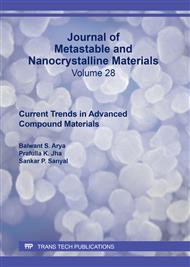[1]
A. J. Freeman, G.H. Lander, Handbook of the Physics and Chemistry of the Actinides, first ed., Amsterdam, North-Holland, 1984, pp.45-130.
Google Scholar
[2]
M. Aynyas, J. Pataiya, B. S. Arya, A. Singh, and S. P. Sanyal, Structural and mechanical properties of thorium carbide J. of Physics, Con. Series 1665 (2015) 030022-030023.
DOI: 10.1063/1.4917597
Google Scholar
[3]
J. M. Leger, Chalcogenides and pnictides of cerium and uranium under high pressure, Physica B 190 (1993) 84-91.
DOI: 10.1016/0921-4526(93)90447-e
Google Scholar
[4]
S. Aydin, A. Tatar, Y. O. Ciftci, A theoretical study for thorium monocarbide (ThC), J. Nucl. Matter 429 (2012) 55-69.
DOI: 10.1016/j.jnucmat.2012.05.038
Google Scholar
[5]
I. R. Shein, K. I. Shein, A. L. Ivanovskii, First principle study of B1 like thorium carbide nitride and oxide, J. Nucl. Mat. 353 (2006) 19-26.
DOI: 10.1016/j.jnucmat.2006.02.075
Google Scholar
[6]
C. Makode and Sankar P. Sanyal, Induced Structural Phase Transition and Electronic Properties of Actinide Monophospides: Ab-Initio Calculations, Physica B: Condensed Matter 406 (2011) 3175-3179.
DOI: 10.1016/j.physb.2011.05.020
Google Scholar
[7]
A. Singh, V. Srivastava, M. Aynyas, and S. P. Sanyal, High pressure structural phase transition and elastic properties of yttrium pnictides, Physica B 404 (2009) 1852-1857.
DOI: 10.1016/j.physb.2009.03.003
Google Scholar
[8]
M. Aynyas, S.P. Sanyal, P.K. Jha, Structural phase transition and elastic properties of thorium pnictides at high pressure, Phys. Status Solidi B 229 (2002) 1459-1466.
DOI: 10.1002/1521-3951(200202)229:3<1459::aid-pssb1459>3.0.co;2-j
Google Scholar
[9]
P. K. Jha, S. P. Sanyal, Structural phase transition and high-pressure behaviour of curium and uranium monobismuthides, J. of physics and Chemistry of Solids 64 (2003) 1237-1240.
DOI: 10.1016/s0022-3697(03)00080-5
Google Scholar
[10]
P.K. Jha, S.P. Sanyal, Phonon spectrum and lattice specific heat of the HgBa 2 CuO 4 high-temperature superconductor, Physica C: Superconductivity 271 (1), 6-10 (1996).
DOI: 10.1016/s0921-4534(96)00536-9
Google Scholar
[11]
P.K. Jha, S.P. Sanyal, A lattice dynamical study of the role of pressure on Raman modes in high-T c HgBa 2 CuO 4, Physica C: Superconductivity 261 (3), 259-262 (1996).
DOI: 10.1016/0921-4534(96)00148-7
Google Scholar
[12]
P.K. Jha and S.P. Sanyal, Lattice vibrations in intermediate valence compounds SmS and TmSe, Indian Journal of Pure and Applied Physics 31 (1993), 469-473 (1993).
Google Scholar
[13]
U. Benedict, Structural data of the actinide elements and of their binary compounds with non-metallic elements, J. Less Common Met. 128 (1987) 7-45.
DOI: 10.1016/0022-5088(87)90189-5
Google Scholar
[14]
M. Born and K. Hung, Dynamical theory of crystal lattice, second ed., Clarendon, Oxford, 1954, pp.120-190.
Google Scholar


